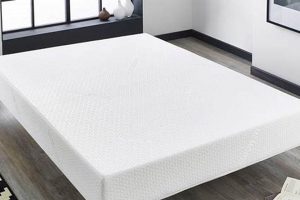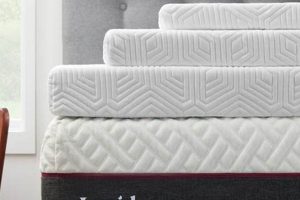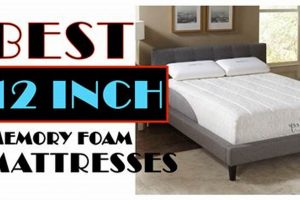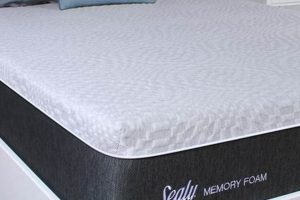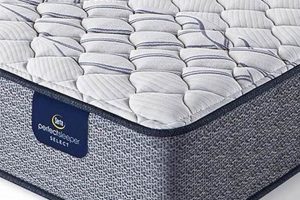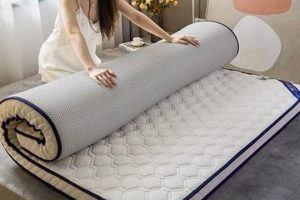A sleeping surface constructed with viscoelastic foam is often chosen for its conforming properties. This material, commonly referred to as a type of cushioning in mattresses, responds to body heat and weight, molding to the sleeper’s shape. This characteristic distinguishes it from traditional innerspring or hybrid designs.
The popularity of such mattresses stems from perceived pressure relief and motion isolation. The ability of the material to distribute weight evenly can alleviate pressure points, potentially improving sleep quality for individuals with joint pain or other discomforts. Historically, this type of foam was developed for NASA to improve the safety of aircraft cushions, later finding broader applications in consumer products.
While its conforming nature offers potential advantages, certain drawbacks exist. Factors such as heat retention, off-gassing, and potential limitations in support should be carefully considered before making a purchase decision. The following sections will explore these factors in greater detail, providing a balanced overview to aid in informed consumer choice.
Guidance for Prospective Buyers
Selecting a mattress requires careful evaluation of individual needs and preferences. The following tips offer guidance when considering options constructed with viscoelastic foam.
Tip 1: Density Assessment: Higher density foam generally correlates with increased durability and support. Inquire about the foam’s density rating and compare specifications across different models to gauge potential longevity.
Tip 2: Heat Dissipation Considerations: Viscoelastic foam can retain heat. Seek out mattresses incorporating cooling technologies, such as gel infusions or open-cell structures, to mitigate potential discomfort from overheating.
Tip 3: Support Layer Evaluation: Examine the support core beneath the viscoelastic layer. A robust base, often composed of high-density polyfoam or innersprings, is crucial for proper spinal alignment and overall support.
Tip 4: Off-Gassing Period: New mattresses may emit a noticeable odor due to volatile organic compounds (VOCs). Allow the mattress to air out in a well-ventilated area for several days before use to minimize this effect.
Tip 5: Motion Isolation Testing: If sharing a bed, assess the mattress’s ability to isolate motion. A partner’s movements should not significantly disrupt sleep on the other side of the bed.
Tip 6: Trial Period Utilization: Take advantage of any available trial periods. This allows for a real-world assessment of comfort and suitability over an extended timeframe.
Tip 7: Warranty Review: Scrutinize the mattress warranty, paying attention to coverage details, exclusions, and the manufacturer’s return policy.
These considerations will assist in selecting a suitable sleeping surface by balancing the desired feel with practical needs.
Considering the information provided, consumers can make a more informed decision when selecting a suitable model.
1. Pressure Relief
The conforming nature of viscoelastic foam is fundamentally linked to its pressure-relieving properties. The material’s ability to distribute body weight across a larger surface area reduces concentrated pressure on specific areas, such as the hips, shoulders, and knees. This characteristic differentiates such mattresses from traditional innerspring models, which may create pressure points due to localized spring compression. Individuals with conditions like arthritis or fibromyalgia often report a reduction in pain and improved sleep quality attributed to this pressure redistribution. For example, a side sleeper might experience reduced shoulder discomfort due to the foam’s ability to cradle the shoulder, preventing it from bearing the full weight of the body.
However, the degree of pressure relief is directly related to the foam’s density and thickness. A mattress with a thin or low-density viscoelastic layer may not provide sufficient pressure relief for heavier individuals or those with pronounced pressure points. Furthermore, the underlying support core must adequately complement the foam layer. If the support core is too soft or yielding, the sleeper may sink too deeply into the mattress, negating the pressure-relieving benefits and potentially causing spinal misalignment. Consequently, evaluating pressure relief involves not only the presence of viscoelastic foam but also its specific characteristics and interaction with the underlying support structure.
In summary, pressure relief constitutes a significant advantage of viscoelastic foam mattresses, contributing to their potential for improved sleep comfort and pain reduction. Its effectiveness hinges on appropriate foam density, thickness, and the complementary nature of the support core. Therefore, when assessing the overall value proposition, the interaction between pressure relief and these other factors must be carefully considered to determine suitability for individual needs.
2. Motion Isolation
Motion isolation, referring to a mattress’s capacity to minimize the transfer of movement, represents a significant factor in evaluating its suitability. This characteristic, particularly relevant for couples or individuals sharing a bed, directly influences sleep quality by reducing disturbances caused by a partner’s tossing and turning.
- Mechanism of Damping
Viscoelastic foam excels at absorbing and dissipating energy. When movement occurs on one side of the mattress, the foam’s dense, viscous nature dampens the vibrations, preventing them from propagating across the surface. This contrasts with innerspring mattresses, where interconnected coils can transmit motion more readily.
- Density and Thickness Impact
The effectiveness of motion isolation is directly related to the density and thickness of the viscoelastic foam layer. Higher density foams generally exhibit superior motion isolation capabilities due to their increased mass and damping properties. Thicker layers provide a greater buffer, further reducing motion transfer. Conversely, thin or low-density foam layers may offer minimal motion isolation benefits.
- Support Core Contribution
While viscoelastic foam plays a primary role, the support core also influences motion isolation. A stable and non-responsive support core, such as a high-density polyfoam base, enhances motion isolation by preventing movement from propagating through the entire mattress structure. An unstable or overly responsive support core, like a system with highly flexible springs, may diminish the effectiveness of the foam layer.
- Real-World Implications
In practical terms, superior motion isolation translates to less sleep disru
ption for bed partners. For instance, if one individual frequently gets up during the night, a mattress with effective motion isolation can minimize disturbances to the other sleeper. Conversely, a mattress with poor motion isolation may result in frequent awakenings and diminished sleep quality.
The assessment of motion isolation capabilities must be considered holistically, considering the interplay between the foam layer, support core, and individual sleep habits. Potential purchasers should assess the relative importance of this quality against other elements such as price, cooling, and general support to make a well-informed purchase.
3. Heat Retention
Heat retention is a significant consideration when evaluating mattresses containing viscoelastic foam. The closed-cell structure of traditional viscoelastic foam restricts airflow, potentially trapping body heat and leading to discomfort, particularly for individuals who sleep hot. This characteristic directly impacts the sleep experience, potentially negating other benefits such as pressure relief. For example, a person prone to night sweats may find that a mattress exacerbates the issue, leading to restlessness and interrupted sleep. Conversely, in colder climates, some individuals may perceive heat retention as a benefit, providing added warmth during sleep. Therefore, the climate and individual thermoregulation needs should be considered.
Manufacturers have attempted to address the heat retention issue through various design innovations. Gel infusions, open-cell foam structures, and phase-change materials are incorporated to improve airflow and dissipate heat. Gel-infused foam aims to draw heat away from the body, while open-cell structures create channels for air circulation. Phase-change materials absorb and release heat to maintain a more consistent temperature. The effectiveness of these technologies varies, and consumer reviews often provide insights into their real-world performance. The density of the foam itself is another influencing factor; higher-density foams generally retain more heat than lower-density options. The layering of materials within the mattress construction also plays a part, with breathable cover fabrics and ventilation channels further promoting airflow.
In conclusion, heat retention represents a notable drawback of some viscoelastic foam mattresses, potentially impacting sleep quality. While manufacturers have developed strategies to mitigate this issue, the effectiveness of these solutions varies. Consumers must carefully assess their personal temperature preferences, climate, and the specific design features of the mattress to determine its suitability. The presence of heat retention is a critical element in evaluating the overall value proposition, particularly when considering other pros and cons such as pressure relief and motion isolation.
4. Support Quality
Support quality in a mattress directly impacts spinal alignment and overall comfort, influencing the suitability of viscoelastic foam designs. Insufficient or uneven support can negate the pressure-relieving benefits of the material, leading to discomfort and potential health issues. Therefore, assessing the support characteristics is critical when evaluating the advantages and disadvantages of this mattress type.
- Core Density and Composition
The density and composition of the support core dictate the mattress’s ability to maintain spinal alignment. High-density polyfoam or innerspring systems are commonly used to provide a stable foundation. If the core is too soft or yielding, the sleeper may sink too deeply, resulting in spinal curvature and back pain. Conversely, a core that is too firm may not allow for proper contouring, diminishing the pressure-relieving advantages of the viscoelastic foam. Therefore, core density and material selection are critical factors in determining overall support quality.
- Zoned Support Systems
Zoned support systems incorporate variations in firmness across different mattress areas to provide targeted support to specific body regions. For example, firmer support may be provided in the lumbar region to prevent sagging, while softer support may be offered in the shoulder area to accommodate side sleeping. These systems aim to optimize spinal alignment and pressure relief simultaneously. However, the effectiveness of zoned support depends on the accuracy of the zoning and its alignment with the sleeper’s body. Poorly designed zoned systems may create pressure points or fail to provide adequate support in critical areas.
- Edge Support Reinforcement
Edge support refers to the stability of the mattress perimeter. Reinforced edges prevent sagging and allow sleepers to utilize the full surface area of the mattress. Insufficient edge support can lead to a feeling of rolling off the bed and make it difficult to sit comfortably on the edge. Edge support is typically achieved through the use of high-density foam rails or reinforced coils along the mattress perimeter. Robust edge support enhances the overall usability and perceived stability of the mattress.
- Layering and Transition
The transition between the viscoelastic foam comfort layer and the support core significantly influences the overall feel and support quality. A smooth and gradual transition prevents a sensation of bottoming out or abrupt changes in firmness. Intermediate layers of transitional foam are often used to create a more seamless feel. Poor layering can result in a disjointed feel and diminished support, particularly for heavier individuals or those who prefer a firmer sleeping surface.
In summary, support quality represents a key element in evaluating viscoelastic foam mattresses. The interplay between core density, zoned support, edge reinforcement, and layering dictates the mattress’s ability to promote spinal alignment and long-term comfort. Potential purchasers must carefully assess these factors to determine the suitability of a mattress based on individual needs and preferences. The effectiveness of pressure relief and motion isolation are contingent upon adequate support, emphasizing the importance of considering support quality as an integral aspect of the decision-making process.
5. Durability
Durability is a critical factor influencing the overall assessment of viscoelastic foam mattresses. A mattress’s lifespan directly affects its long-term value and influences the extent to which its initial benefits, such as pressure relief and motion isolation, are sustained over time. Material degradation, loss of support, and the development of impressions contribute to a decline in performance, ultimately impacting sleep quality and necessitating replacement. For example, a mattress with a high density viscoelastic layer may maintain its support and contouring properties for several years, while a lower density foam could exhibit significant sagging within a shorter timeframe, thus affecting the return on investment.
The durability of these mattresses is dependent on several interconnected factors, including foam density, construction techniques, and the quality of materials used in both the comfort layers and support co
re. Higher density foams typically exhibit greater resistance to compression and deformation, leading to increased longevity. The type of support core, whether it be high-density polyfoam or innerspring, also influences the overall durability. Furthermore, proper maintenance, such as regular rotation, can prolong the lifespan of a viscoelastic mattress. Cases exist where well-maintained, high-quality viscoelastic mattresses have provided satisfactory performance for up to a decade, whereas poorly constructed or neglected mattresses may require replacement within a few years.
Therefore, when evaluating a mattress, potential purchasers must consider durability alongside other factors, such as price and comfort. While a lower-priced mattress may seem appealing initially, its lack of durability could result in higher long-term costs due to premature replacement. Assessing material specifications, warranty terms, and user reviews provides valuable insights into the potential longevity of a given model. Ultimately, a balance between initial cost and projected lifespan is necessary to make an informed purchase decision and maximize the long-term benefits derived from a viscoelastic foam mattress.
6. Off-Gassing
Off-gassing, the release of volatile organic compounds (VOCs) from materials, represents a notable disadvantage associated with many viscoelastic foam mattresses. These compounds, used in the manufacturing process, can emit odors upon initial unboxing. The intensity and duration of off-gassing vary, contingent upon foam composition, density, and manufacturing protocols. While often harmless, VOCs can trigger respiratory irritation or headaches in sensitive individuals, thus influencing the comfort level. This phenomenon directly affects the mattress’s desirability, potentially offsetting its benefits such as pressure relief or motion isolation. For example, an individual highly sensitive to chemical odors might find the initial weeks after purchasing a new mattress unbearable, irrespective of the product’s other performance attributes. Therefore, off-gassing must be considered within a comprehensive assessment of the mattress’s benefits and drawbacks.
Mitigating off-gassing involves several strategies. Manufacturers often employ ventilation techniques during production to reduce residual VOC levels. Consumers can further minimize exposure by airing out the mattress in a well-ventilated room for several days prior to use. Certain certifications, such as CertiPUR-US, indicate that the foam has been tested for low VOC emissions, providing assurance of reduced off-gassing potential. However, even certified foams may exhibit some initial odor, albeit generally at lower levels. Material selection, such as the use of plant-based or bio-based foams, can also influence VOC emissions. The effectiveness of these strategies varies, and consumer experiences provide anecdotal evidence of their impact. For instance, some users report minimal odor from certified mattresses, while others perceive a persistent smell even after prolonged airing.
In summary, off-gassing constitutes a practical concern linked to viscoelastic foam mattresses. While the intensity and duration of VOC emissions vary, the potential for respiratory irritation or discomfort necessitates careful consideration. Strategies such as airing out, seeking certifications, and choosing specific materials can minimize exposure. Assessing the trade-offs between potential off-gassing and other benefits, such as pressure relief and motion isolation, is crucial for making an informed purchasing decision. The issue of off-gassing highlights the importance of evaluating not only the functional properties but also the potential health and environmental implications associated with mattress selection.
7. Cost
The financial investment required for a viscoelastic foam mattress represents a significant aspect in the overall evaluation of its merits and drawbacks. The cost factor influences accessibility and often dictates the degree to which prospective buyers can prioritize specific features and benefits.
- Initial Purchase Price
Viscoelastic foam mattresses can range widely in price, depending on factors such as foam density, thickness, brand reputation, and incorporated technologies (e.g., gel infusions, zoned support). Entry-level models may offer a lower initial cost, but often compromise on durability or performance. Higher-end models, while more expensive upfront, may provide superior comfort, support, and longevity, potentially justifying the increased investment over time. A consumer must evaluate if the promised features align with actual needs and if the cost outweighs the perceived improvements relative to more economical options.
- Long-Term Replacement Expenses
The lifespan of a mattress directly impacts its long-term cost-effectiveness. A less expensive mattress that degrades quickly and requires frequent replacement can ultimately prove more costly than a higher-priced, more durable alternative. Considerations should include the potential for sagging, loss of support, and compression of the foam over time, all of which can necessitate earlier replacement. The warranty offered by the manufacturer also provides an indicator of expected lifespan and potential replacement costs.
- Added Accessory Expenses
The properties of viscoelastic foam may necessitate the purchase of additional accessories to optimize comfort and performance. For example, due to potential heat retention, a cooling mattress protector or breathable sheets may be required. Similarly, the unique feel of viscoelastic foam may necessitate a different type of pillow to maintain proper spinal alignment. These added expenses contribute to the overall cost of ownership and should be factored into the purchasing decision. Not considering such ancillary costs may lead to an underestimation of the complete financial burden.
- Health-Related Costs
An unsuitable mattress can contribute to or exacerbate existing health conditions, such as back pain or allergies, potentially leading to increased healthcare costs. Conversely, a well-chosen viscoelastic foam mattress may alleviate pressure points and improve sleep quality, potentially reducing the need for medical interventions. These potential health-related cost implications, while difficult to quantify, represent a significant consideration in the overall evaluation. Investing in a mattress that aligns with individual health needs may offer long-term cost savings in the form of reduced medical expenses.
The cost of a viscoelastic foam mattress must be evaluated holistically, considering not only the initial purchase price but also long-term replacement expenses, accessory costs, and potential health-related implications. By weighing these factors, consumers can make a more informed decision that balances financial considerations with the desire for improved sleep quality and overall well-being.
Frequently Asked Questions
This section addresses common inquiries regarding viscoelastic foam mattresses, aiming to provide clarity on their characteristics and suitability for various needs.
Question 1: How does viscoelastic foam provide pressure relief?
Viscoelastic foam conforms to the body’s contours, distributing weight evenly and reducing concentrated pressure on specific areas, such as hips and shoulders.
Question 2: Is
a viscoelastic foam mattress suitable for individuals who sleep hot?
Traditional viscoelastic foam can retain heat due to its closed-cell structure. However, some mattresses incorporate cooling technologies like gel infusions or open-cell structures to improve airflow and mitigate heat retention.
Question 3: What is the expected lifespan of a viscoelastic foam mattress?
The lifespan varies based on foam density, construction quality, and maintenance. Higher-density foams generally exhibit greater durability and can last longer than lower-density alternatives.
Question 4: What is off-gassing, and is it harmful?
Off-gassing refers to the release of volatile organic compounds (VOCs) from the foam. While often harmless, VOCs can cause temporary odors and may trigger respiratory irritation in sensitive individuals. Airing out the mattress before use can minimize this effect.
Question 5: How does viscoelastic foam isolate motion?
The dense, viscous nature of viscoelastic foam absorbs and dampens vibrations, preventing motion from transferring across the mattress surface. This is particularly beneficial for couples or individuals sharing a bed.
Question 6: What factors influence the cost of a viscoelastic foam mattress?
Factors such as foam density, thickness, brand reputation, incorporated technologies, and construction quality all contribute to the overall cost.
In summary, these frequently asked questions highlight key considerations when evaluating viscoelastic foam mattresses, including pressure relief, heat retention, durability, off-gassing, motion isolation, and cost.
Moving forward, the next segment will synthesize these factors and provide a comprehensive conclusion.
Conclusion
The preceding analysis of the pros and cons of memory foam mattress reveals a complex interplay of factors impacting suitability. The material offers demonstrable advantages in pressure relief and motion isolation. However, inherent limitations in heat dissipation and potential for off-gassing necessitate careful consideration. Factors such as foam density, support core composition, and manufacturing processes significantly influence durability and long-term value. Ultimately, the decision to adopt this bedding solution requires a balanced assessment of individual needs and preferences against the outlined benefits and drawbacks.
Given the multifaceted nature of these mattresses, prospective purchasers should engage in thorough research and, when possible, utilize trial periods to assess suitability in a real-world context. The continued evolution of materials science and manufacturing techniques may offer future solutions to mitigate existing limitations, further enhancing the appeal of viscoelastic foam mattresses. A deliberate approach, grounded in informed understanding, will optimize the likelihood of achieving a satisfactory and beneficial outcome.


